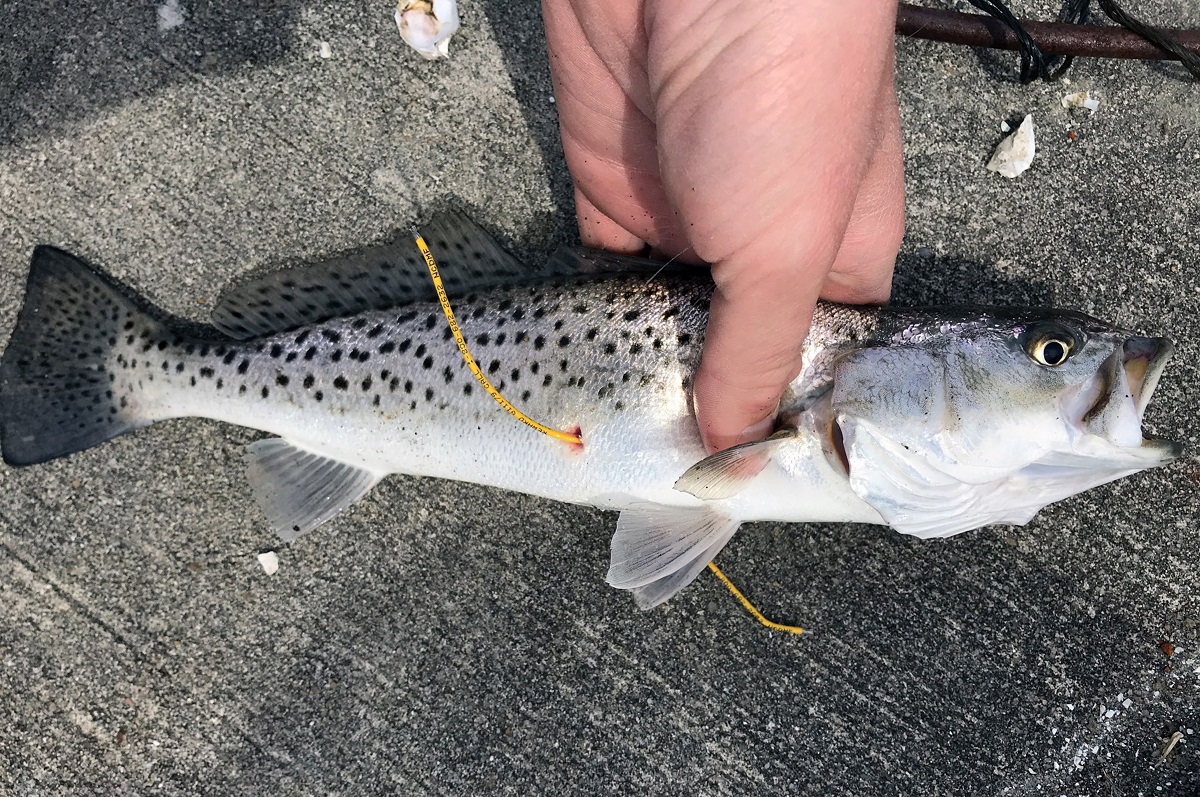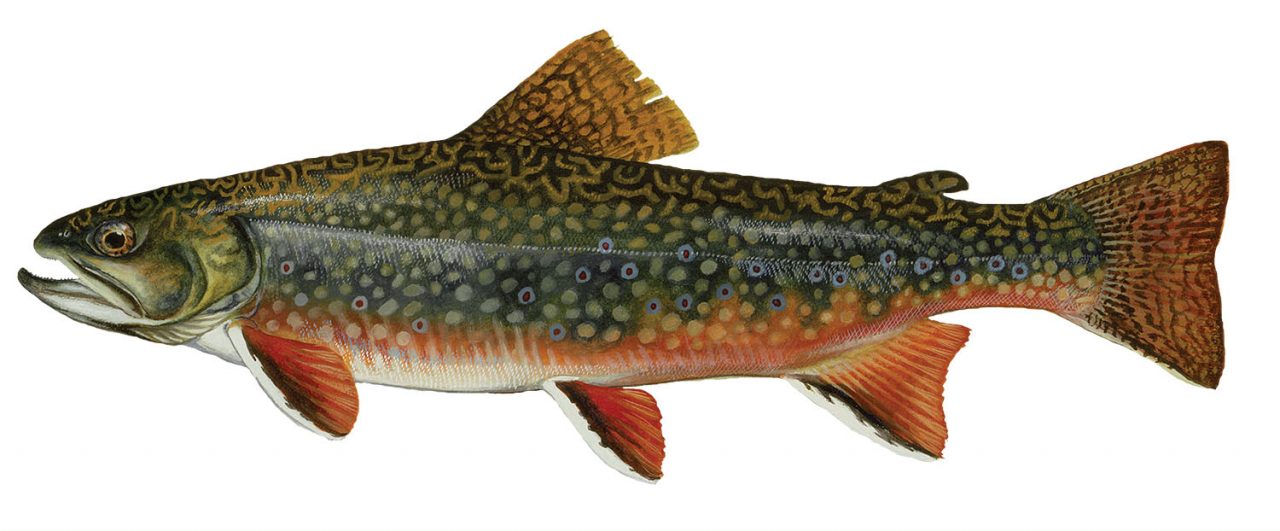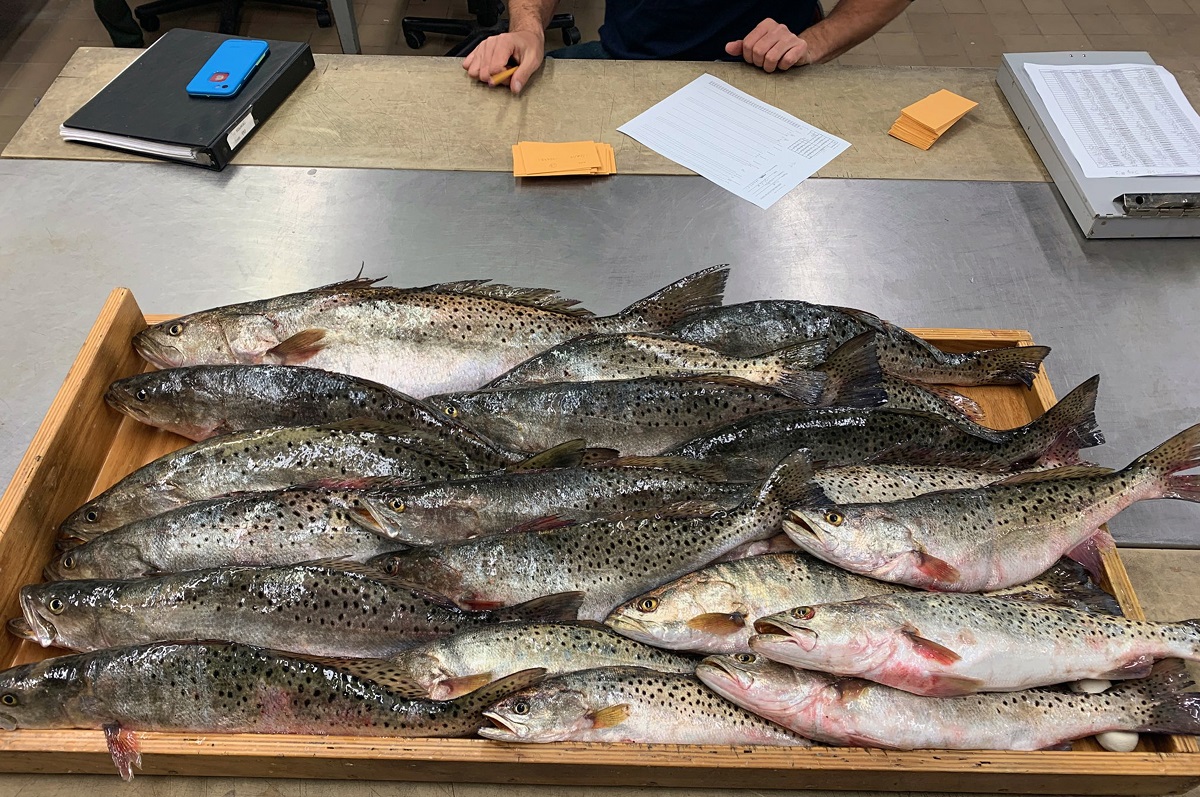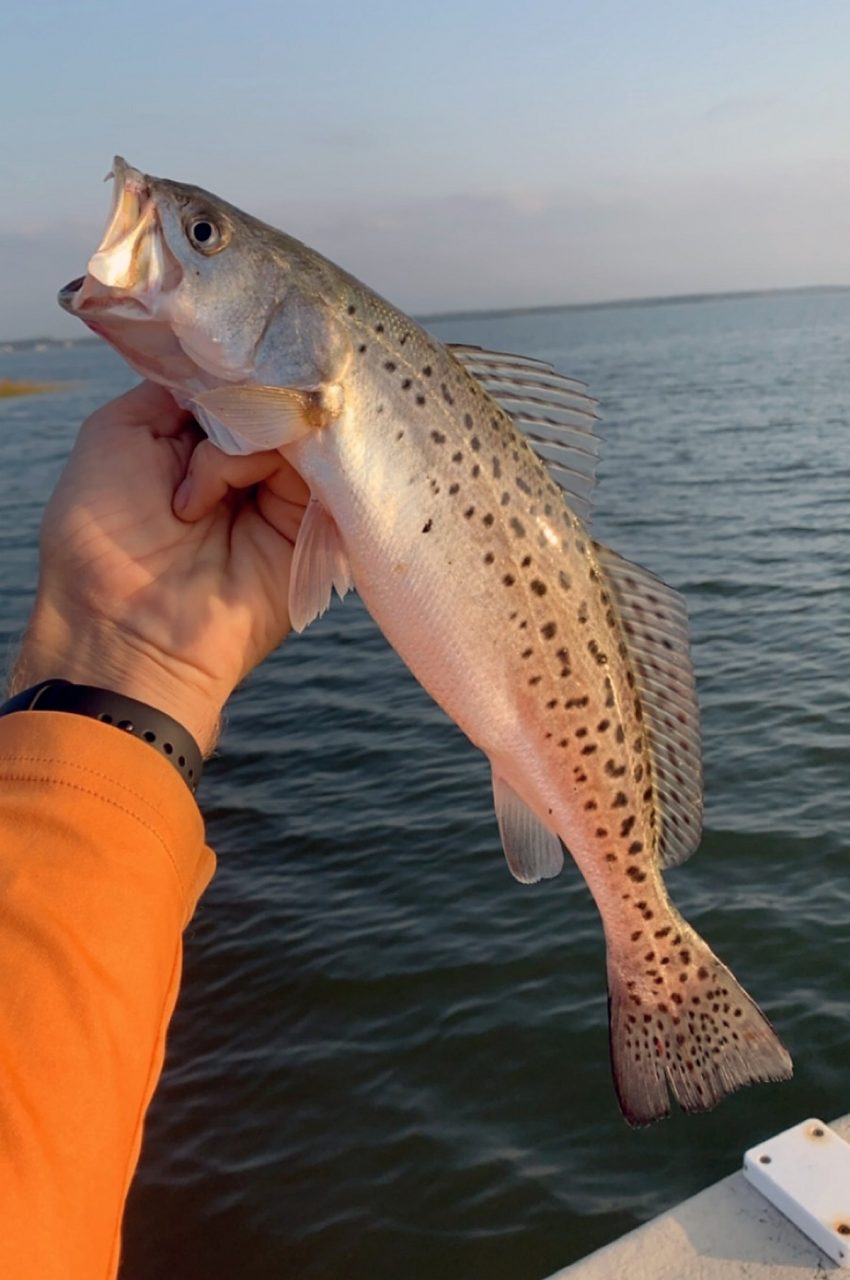
The spotted seatrout’s name gets me a bit confused. One of the common nicknames for this species is “speckled trout.”
To me, the term “speckled trout” is another name for the eastern brook trout, which is found in the freshwater reaches of the mountainous region of North Carolina.
Supporter Spotlight
Though these two share a nickname, it is very easy to tell the two species apart from one another.
First, if you are fishing in the ocean, or brackish waters of North Carolina, you’ll definitely hook a spotted seatrout, commonly referred to as speckled trout, but not an eastern brook trout.
While there are sea-run populations of eastern brook trout along the U.S. Atlantic coast, North Carolina is not one of the states that are home to that variant of the freshwater brook trout. Brook trout are found on the western edge of North Carolina in and around the Appalachian Mountains, and the cold water streams that are found in that region.

Eastern brook trout always have white markings on the front edge of their fins, while speckled trout do not have any white markings. Though both fish have spots along the sides of their bodies, speckled trout also lack wavy vermiculation’s on their back which are a species indicator of the eastern brook trout.
Tracey Bauer, fisheries biologist with the state Division of Marine Fisheries, told Coastal Review that spotted seatrout, or speckled trout, can be found from Massachusetts on the U.S. Atlantic Coast, to southern Florida and the Bahamas, and continue through the Gulf of Mexico to the Yucatan Peninsula, Mexico.
Supporter Spotlight
“They inhabit shallow coastal and estuarine waters throughout their range and are considered a species that is tolerant of a wide variety of salinities, from the ocean to brackish waters,” Bauer said.
In North Carolina, the state record for spotted seatrout was 12.3 pounds and landed in 1961. Spotted seatrout will live to be an average of 9 years old in North Carolina for both male and female fish.
Bauer explained that spotted seatrout in North Carolina are mature by the time they are about a year old, with an average length of 7.9 inches for males and 9.9 inches for females.

“All males are mature by the time they reach 12 inches and females at 15 inches in length. Spawning in North Carolina usually takes place from April through October with a peak in spawning activity typically during the month of May. Spawning takes place shortly after sunset and a single fish is capable of spawning multiple times throughout the season, making them a batch spawner,” Bauer said.
In Florida, it has been observed that during peak spawning, spotted seatrout older than 3 years old might spawn every two days while younger fish can spawn as often as every four days.
Estimates for the number of eggs a female from the southeast and Gulf coasts can produce in a year can vary from 3 million to 20 million. “Typically, with most trout, the number of eggs she can release really comes down to the size of the female, how old she is, and where she lives,” she said.
Spotted seatrout are targeted by recreational and commercial fishermen throughout their range, Bauer continued. In North Carolina, commercial fishermen land spotted seatrout using many different gears, including runaround gill nets, long haul seines, beach seines, but estuarine gill nets are the most common.
“Traditionally, the species has mostly been harvested as bycatch in other fisheries targeting Atlantic croaker, spot, striped mullet, or southern flounder, but a fishery targeting spotted seatrout takes place in the fall and winter months when spotted seatrout are plentiful. Spotted seatrout are harvested throughout the year with two peaks in landings: October through February and April through May. Total commercial landings fluctuate from year to year, and in the past 10 years have ranged from a low of 75,000 pounds in 2011 to a high of 568,764 pounds in 2020,” Bauer said.

Bauer is both the fisheries biologist for this species and the lead management person for spotted seatrout in North Carolina waters.
In addition to being one of the most targeted recreational fish species in the state, it’s also the top-ranked targeted species in the entire South Atlantic region of the United States. The recreational harvest of spotted seatrout averages more than seven times the amount of commercial harvest annually.
“Fishermen usually target spotted seatrout with hook and line gear using a variety of natural and artificial baits. Additionally, some spotted seatrout are landed by Recreational Commercial Gear License holders using gill nets. Fishing effort occurs all year in the recreational fishery with the majority of the landings from September through December when the fish have moved into coastal and inland creeks and rivers,” Bauer said.
Recreational fishermen in North Carolina harvest, on average, 1.1 million spotted seatrout or over 1.9 million pounds a year, second only to Florida. “Releases of spotted seatrout most years are at least double the number of fish kept,” Bauer reported.
The North Carolina Marine Fisheries Commission currently manages the spotted seatrout fishery under the state Spotted Seatrout Fishery Management Plan, adopted in 2012, and Supplement A to the Spotted Seatrout Fishery Management Plan, adopted in 2014.
Bauer said that the management plan measurements include a 14-inch total length minimum size limit for commercial and recreational fishermen, a four fish per person per day bag limit for recreational fishermen, and a 75-fish trip limit for commercial fishermen.
“The objectives of the fishery management plan and the supplement are to reduce fishing mortality to a level that maintains a spawning stock that is 20% of the unfished stock to increase the likelihood of the stock replenishing itself after years of high mortality. This is a conservative approach, which should provide a greater cushion for the population and lead to a quicker recovery in case a natural mortality event, such as a cold stun, causes depletion of the stock,” Said Bauer.
Spotted seatrout is also covered under the North Carolina Interjurisdictional Fishery Management Plan, which ensures that the state is complying with all federal and council fishery management plans.
“The Atlantic States Marine Fisheries Commission manages spotted seatrout as an interjurisdictional species and requires that the member states adopt regulations that meet its management measures. The Atlantic States Fishery Management Plan requires that all states set at least a 12-inch minimum size limit for spotted seatrout,” she said.
A stock assessment was completed on spotted seatrout in North Carolina and Virginia in 2014 and indicated that the stock was not overfished, or that the stock size was in good shape, and that overfishing was not occurring, meaning that removals from fishing were considered sustainable for a long-term benefit of the stock, between 1991 and 2012.

Bauer said that a management threshold of 870,000 pounds and target of 1.37 million pounds were set based on the spawning potential ratio, or the reproductive potential of a fished stock compared to its unfished level of 20 and 30%, respectively. “If the spawning stock biomass of spotted seatrout falls below these levels, management measures will be considered to reduce harvest and rebuild the stock.”
The assessment estimated that the spawning stock biomass, or weight of mature females in the stock, during the final year of the assessment in 2012, was more than 2.5 million pounds, so well above both the management threshold and target.
For fishing mortality, or the rate at which fish in a stock die because of commercial and recreational fishing, a management threshold of 0.656 and target of 0.422 were set, also based a 20 and 30% reduction in spawning potential caused by fishing, Bauer continued.
If fishing mortality increases above these levels, management measures will be considered to reduce harvest and rebuild the stock. “The 2014 assessment estimated that fishing mortality during the final year of the assessment (2012) was 0.401, which was close to the fishing mortality target, but still below the threshold, indicating overfishing was not occurring,” Bauer said.
According to the North Carolina Division of Marine Fisheries website, numerous surveys will take place each year to keep a close eye on the spotted seatrout population and to collect information that may be used during future stock assessments.
A juvenile index for spotted seatrout is calculated each year from the North Carolina Estuarine Juvenile Trawl Survey in June and July, and serves as an indicator of juvenile abundance in the state. Results from the survey typically track well with years following a cold stun and can give an indication of the recovery. Following a peak in 2018, the average number of fish per tow decreased in 2019, and again in 2020 to the lowest abundance since the survey began in 2004.
“Research needs include obtaining size-specific and batch fecundity estimates for spotted seatrout in North Carolina; identifying spawning areas, and developing area-specific spawning surveys; investigating the relationship of temperature and salinity on release mortality in the commercial and recreational fisheries, and collecting discard information from the commercial and recreational fisheries,” she said.
A new stock assessment for spotted seatrout incorporating data through February 2020 is in the process of being developed and scheduled to be completed in early 2022. This will provide updated information on the status of the spotted seatrout stock in North Carolina and Virginia, Bauer added.








